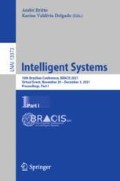Abstract
Co-clustering is a specific type of clustering that addresses the problem of simultaneously clustering objects and attributes of a data matrix. Although general clustering techniques find non-overlapping co-clusters, finding possible overlaps between co-clusters can reveal embedded patterns in the data that the disjoint clusters cannot discover. The overlapping co-clustering approaches proposed in the literature focus on finding global overlapped co-clusters and they might overlook interesting local patterns that are not necessarily identified as global co-clusters. Discovering such local co-clusters increases the granularity of the analysis, and therefore more specific patterns can be captured. This is the objective of the present paper, which proposes the new Overlapped Co-Clustering (OCoClus) method for finding overlapped co-clusters on binary data, including both global and local patterns. This is a non-exhaustive method based on the co-occurrence of attributes and objects in the data. Another novelty of this method is that it is driven by an objective cost function that can automatically determine the number of co-clusters. We evaluate the proposed approach on publicly available datasets, both real and synthetic data, and compare the results with a number of baselines. Our approach shows better results than the baseline methods on synthetic data and demonstrates its efficacy in real data.
Access this chapter
Tax calculation will be finalised at checkout
Purchases are for personal use only
Notes
- 1.
- 2.
- 3.
- 4.
https://ti.saude.rs.gov.br/covid19/; just passed away people data were used.
References
Affeldt, S., Labiod, L., Nadif, M.: Ensemble block co-clustering: a unified framework for text data. In: Proceedings of the 29th ACM International Conference on Information & Knowledge Management, pp. 5–14 (2020)
Brunialti, L.F., Peres, S.M., da Silva, V.F., de Moraes Lima, C.A.: The BinOvNMTF algorithm: overlapping columns co-clustering based on non-negative matrix tri-factorization. In: 2017 Brazilian Conference on Intelligent Systems (BRACIS), pp. 330–335. IEEE, Uberlandia, Brazil (2017)
Dhillon, I.S.: Co-clustering documents and words using bipartite spectral graph partitioning. In: Proceedings of the Seventh ACM SIGKDD International Conference on Knowledge Discovery and Data Mining, pp. 269–274. ACM, Association for Computing Machinery, New York (2001)
Fu, Q., Banerjee, A.: Bayesian overlapping subspace clustering. In: 2009 Ninth IEEE International Conference on Data Mining, pp. 776–781. IEEE (2009)
Hartigan, J.A.: Direct clustering of a data matrix. J. Am. Stat. Assoc. 67(337), 123–129 (1972)
Kluger, Y., Basri, R., Chang, J.T., Gerstein, M.: Spectral biclustering of microarray data: coclustering genes and conditions. Genome Res. 13(4), 703–716 (2003)
Li, G.: Generalized co-clustering analysis via regularized alternating least squares. Comput. Stat. Data Anal. 150, 106989 (2020)
Lucchese, C., Orlando, S., Perego, R.: A generative pattern model for mining binary datasets. In: Proceedings of the 2010 ACM Symposium on Applied Computing, pp. 1109–1110. ACM (2010)
Lucchese, C., Orlando, S., Perego, R.: A unifying framework for mining approximate top-\( k \) binary patterns. IEEE Trans. Knowl. Data Eng. 26(12), 2900–2913 (2013)
Lutov, A., Khayati, M., Cudré-Mauroux, P.: Accuracy evaluation of overlapping and multi-resolution clustering algorithms on large datasets. In: 2019 IEEE International Conference on Big Data and Smart Computing (BigComp), Kyoto, Japan. IEEE (2019)
Madeira, S.C., Oliveira, A.L.: Biclustering algorithms for biological data analysis: a survey. IEEE/ACM Trans. Comput. Biol. Bioinform. 1(1), 24–45 (2004)
Padilha, V.A., Campello, R.J.: A systematic comparative evaluation of biclustering techniques. BMC Bioinform. 18(1), 1–25 (2017)
Pio, G., Ceci, M., D’Elia, D., Loglisci, C., Malerba, D.: A novel biclustering algorithm for the discovery of meaningful biological correlations between micrornas and their target genes. BMC Bioinform. 14(S7), S8 (2013)
Role, F., Morbieu, S., Nadif, M.: CoClust: a python package for co-clustering. J. Stat. Softw. 88(1), 1–29 (2019)
Vlachos, M., Dünner, C., Heckel, R., Vassiliadis, V.G., Parnell, T., Atasu, K.: Addressing interpretability and cold-start in matrix factorization for recommender systems. IEEE Trans. Knowl. Data Eng. 31(7), 1253–1266 (2018)
Whang, J.J., Rai, P., Dhillon, I.S.: Stochastic blockmodel with cluster overlap, relevance selection, and similarity-based smoothing. In: 2013 IEEE 13th International Conference on Data Mining. IEEE (2013)
Xu, R., Wunsch, D.: Survey of clustering algorithms. IEEE Trans. Neural Netw. 16(3), 645–678 (2005)
Zheng, et al.: Clustering social audiences in business information networks. Pattern Recognit. 100, 107126 (2020)
Zhu, H., Mateos, G., Giannakis, G.B., Sidiropoulos, N.D., Banerjee, A.: Sparsity-cognizant overlapping co-clustering for behavior inference in social networks. In: 2010 IEEE International Conference on Acoustics, Speech and Signal Processing, pp. 3534–3537. IEEE (2010)
Acknowledgements
This work has been partially supported by CAPES (Finance code 001), CNPQ, FAPESC (Project Match - co-financing of H2020 Projects - Grant 2018TR 1266), and the European Union’s Horizon 2020 research and innovation programme under GA N. 777695 (MASTER). The views and opinions expressed in this paper are the sole responsibility of the author and do not necessarily reflect the views of the European Commission.
Author information
Authors and Affiliations
Corresponding author
Editor information
Editors and Affiliations
Rights and permissions
Copyright information
© 2021 Springer Nature Switzerland AG
About this paper
Cite this paper
dos Santos, Y.S.R.N. et al. (2021). A Co-occurrence Based Approach for Mining Overlapped Co-clusters in Binary Data. In: Britto, A., Valdivia Delgado, K. (eds) Intelligent Systems. BRACIS 2021. Lecture Notes in Computer Science(), vol 13073. Springer, Cham. https://doi.org/10.1007/978-3-030-91702-9_25
Download citation
DOI: https://doi.org/10.1007/978-3-030-91702-9_25
Published:
Publisher Name: Springer, Cham
Print ISBN: 978-3-030-91701-2
Online ISBN: 978-3-030-91702-9
eBook Packages: Computer ScienceComputer Science (R0)

